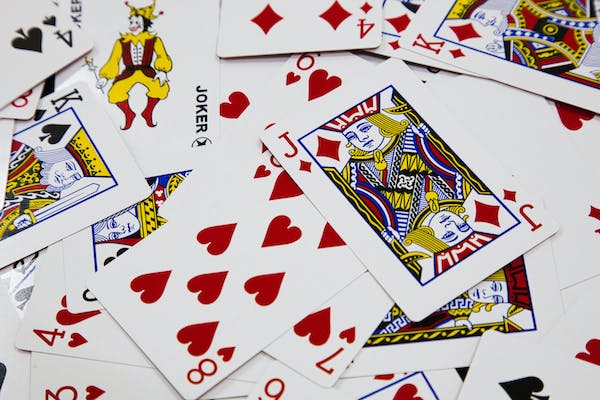The Anatomy of Winning Hands: A Comprehensive Guide to Hand Rankings for Poker Dominance is a detailed and informative resource that delves into the hierarchy of poker hands. This guide provides a comprehensive breakdown of the various hand rankings in poker, enabling players to understand the strength and value of their cards. Whether you are a beginner looking to grasp the fundamentals or an experienced player seeking to enhance your strategic approach, this guide offers valuable insights to help you dominate the game of poker.
Understanding the Hierarchy of Poker Hands: A Step-by-Step Guide
At the top of the poker hand rankings is the Royal Flush. This is the crème de la crème of poker hands, consisting of the Ace, King, Queen, Jack, and Ten of the same suit. It is an unbeatable hand that guarantees victory. However, the chances of getting a Royal Flush are incredibly slim, so don’t count on it too often.
Next in line is the Straight Flush. This hand consists of five cards in numerical order and of the same suit. For example, 5, 6, 7, 8, and 9 of hearts would be a Straight Flush. The only hand that can beat a Straight Flush is a Royal Flush.
Following the Straight Flush is the Four of a Kind. As the name suggests, this hand consists of four cards of the same rank, such as four Aces. If two players have Four of a Kind, the player with the higher rank wins. In the rare event that two players have the same rank Four of a Kind, the fifth card, also known as the kicker, determines the winner.
The Full House is the next hand in the hierarchy. It consists of three cards of the same rank and a pair of another rank. For example, three Kings and two Queens would be a Full House. If two players have a Full House, the player with the higher rank three cards wins.
Moving down the ladder, we have the Flush. This hand consists of any five cards of the same suit, not necessarily in numerical order. If two players have a Flush, the player with the highest-ranking card wins. If the highest-ranking cards are the same, the second-highest card is compared, and so on until a winner is determined.
The Straight is the next hand in line. It consists of five cards in numerical order, regardless of their suit. For example, 3, 4, 5, 6, and 7 of any suit would be a Straight. If two players have a Straight, the player with the highest-ranking card wins.
The Three of a Kind is the next hand on the list. It consists of three cards of the same rank, with two unrelated cards. If two players have Three of a Kind, the player with the higher rank wins. If the ranks are the same, the kickers come into play.
Next up is the Two Pair. As the name suggests, this hand consists of two pairs of cards of the same rank, with one unrelated card. If two players have Two Pair, the player with the highest-ranking pair wins. If the highest-ranking pairs are the same, the second pair is compared, and if necessary, the fifth card determines the winner.
The second-lowest hand is the One Pair. This hand consists of two cards of the same rank, with three unrelated cards. If two players have One Pair, the player with the highest-ranking pair wins. If the pairs are the same, the kickers are compared.
Finally, the lowest hand in the hierarchy is the High Card. This hand does not have any matching ranks or suits. In the event that no player has a winning hand, the player with the highest-ranking card wins.
Understanding the hierarchy of poker hands is essential for any aspiring poker player. It allows you to make informed decisions and strategize your gameplay accordingly. Remember, practice makes perfect, so get out there and start honing your poker skills. Good luck!
Mastering the Royal Flush: The Ultimate Winning Hand in Poker
In poker, hand rankings are crucial. They determine the strength of your hand and your chances of winning. The highest-ranking hand is the royal flush, which consists of the Ace, King, Queen, Jack, and Ten of the same suit. It is the ultimate winning hand, a rare gem that can only be beaten by another royal flush of a higher suit. The odds of being dealt a royal flush are astronomical, making it a truly remarkable feat when achieved.
The royal flush is the epitome of poker dominance. It is a hand that exudes power and confidence, instantly striking fear into the hearts of opponents. When you hold a royal flush, you know you have the best hand possible, and it’s time to capitalize on it. It’s a hand that can turn the tide of a game, propelling you to victory and leaving your opponents in awe.
To master the royal flush, one must understand the odds and probabilities associated with it. As mentioned earlier, the chances of being dealt a royal flush are incredibly slim. In fact, the odds are approximately 1 in 649,740. This rarity adds to the allure and prestige of the hand, making it a coveted achievement for any poker player.
The royal flush is not only a symbol of luck but also a testament to skill and strategy. To have a shot at obtaining this illustrious hand, players must make calculated decisions throughout the game. They must carefully assess their cards, the community cards, and the actions of their opponents. It requires a keen sense of observation, intuition, and the ability to read other players. Only by mastering these skills can one increase their chances of achieving the royal flush.
When a royal flush is achieved, it’s important to play it strategically. Revealing your hand too early can give your opponents an opportunity to fold, minimizing your potential winnings. Instead, it’s often wise to play it cool, gradually building the pot and enticing your opponents to bet more. By doing so, you can maximize your earnings and potentially secure a substantial victory.
In conclusion, the royal flush is the ultimate winning hand in poker. It represents the pinnacle of poker dominance, a hand that is both rare and powerful. To achieve the royal flush, players must possess a combination of luck, skill, and strategy. It is a hand that demands respect and admiration, leaving opponents in awe and securing victory for those fortunate enough to hold it. So, the next time you sit down at a poker table, remember the anatomy of winning hands and strive for the ultimate prize: the royal flush.
Unveiling the Power of Four of a Kind: Strategies for Dominating with Quads
Quads, as the name suggests, refers to a hand that contains four cards of the same rank, accompanied by a fifth card known as the kicker. This hand is considered one of the strongest in poker, and mastering its strategies can significantly enhance your chances of dominating the game.
The first step in utilizing quads effectively is to understand their rarity. With only 13 ranks in a standard deck of cards, the odds of being dealt quads are quite low. However, when you do manage to land this powerful hand, it is crucial to maximize its potential.
One strategy to consider when holding quads is to play aggressively. By betting or raising, you can intimidate your opponents and force them to fold weaker hands. However, it is essential to strike a balance between aggression and subtlety, as overly aggressive play can alert observant opponents to the strength of your hand.
Another key aspect of playing quads is reading the table. Assessing the community cards and your opponents’ reactions can provide valuable insights into their hands. If the board contains cards of the same rank as your quads, it is crucial to be cautious, as there is a possibility that someone else may have a higher-ranked hand, such as a straight flush or a royal flush.
Furthermore, understanding the value of your kicker is vital when playing quads. The kicker can determine the strength of your hand in case of a tie with another player who also has quads. For instance, if you have four kings with an ace kicker, your hand is stronger than someone with four kings and a queen kicker. Therefore, it is crucial to assess the value of your kicker and adjust your strategy accordingly.
Bluffing can also be a powerful tool when playing quads. By representing a weaker hand, you can lure your opponents into making larger bets, ultimately increasing the pot size. However, bluffing should be used sparingly and selectively, as it can backfire if your opponents see through your deception.
In addition to these strategies, it is essential to be aware of the potential dangers when holding quads. One such danger is the possibility of a higher-ranked hand, such as a straight flush or a royal flush. While rare, these hands can be devastating if you become too confident in the strength of your quads. Therefore, it is crucial to remain vigilant and consider the possibility of stronger hands on the table.
In conclusion, mastering the strategies associated with four of a kind, or quads, can significantly enhance your poker game. By understanding the rarity of this hand, playing aggressively, reading the table, assessing the value of your kicker, and utilizing bluffing tactics, you can dominate the game and increase your chances of success. However, it is crucial to remain cautious and aware of potential stronger hands that may be lurking on the table. With practice and experience, you can harness the power of quads and become a formidable force at the poker table.
Decoding the Full House: How to Play and Win with a Strong Hand
In the world of poker, few hands are as powerful and intimidating as the full house. This winning combination consists of three cards of the same rank and a pair of another rank. It is a hand that exudes strength and dominance, and understanding how to play it can greatly increase your chances of success at the poker table.
When you find yourself with a full house, it is important to assess the strength of your hand and make strategic decisions accordingly. The value of a full house is determined by the rank of the three cards forming the set. For example, a full house consisting of three aces and a pair of kings is stronger than a full house with three tens and a pair of twos.
One of the key factors to consider when playing a full house is the strength of your opponents’ hands. If the board shows a possibility of a higher-ranking full house, it is crucial to proceed with caution. For instance, if the community cards reveal three kings and two aces, it is possible that an opponent has a higher-ranked full house with three aces and a pair of kings. In such a scenario, it may be wise to play defensively and avoid making large bets.
On the other hand, if the board does not present any immediate threats, it is time to capitalize on your strong hand. Betting aggressively can help you maximize your winnings and put pressure on your opponents. By making large bets, you force your opponents to make difficult decisions and potentially fold weaker hands. However, it is important to strike a balance and not overplay your hand, as this can lead to unnecessary losses.
Another important aspect of playing a full house is reading your opponents’ reactions and betting patterns. Observing their behavior can provide valuable insights into the strength of their hands. If an opponent suddenly becomes more cautious or starts making smaller bets, it could indicate that they are wary of your full house and are trying to minimize their losses. Conversely, if an opponent becomes more aggressive, it may suggest that they have a strong hand and are trying to challenge your dominance.
In addition to reading your opponents, it is crucial to be aware of the overall dynamics of the game. Understanding the table image you have established can greatly influence your strategy. If you have been playing conservatively and your opponents perceive you as a tight player, they may be more inclined to fold to your aggressive bets. Conversely, if you have been playing more loosely, your opponents may be more likely to call or raise, potentially leading to a larger pot.
Lastly, it is important to remain adaptable and flexible in your approach to playing a full house. Poker is a game of constant change, and what may be a winning strategy in one hand may not work in another. By staying observant and adjusting your tactics accordingly, you can maintain an edge over your opponents and increase your chances of success.
In conclusion, playing a full house requires a combination of skill, strategy, and adaptability. Understanding the strength of your hand, assessing your opponents’ reactions, and reading the overall dynamics of the game are all crucial elements in achieving poker dominance. By mastering the art of playing a full house, you can confidently navigate the poker table and increase your chances of coming out on top.
Revealing the Secrets of the Straight Flush: A Winning Combination in Poker
The game of poker is a thrilling and strategic card game that has captivated players for centuries. One of the key elements of poker is understanding the hierarchy of winning hands. Each hand is ranked based on its rarity and strength, with the ultimate goal being to have the highest-ranking hand at the table. In this comprehensive guide, we will delve into the anatomy of winning hands, starting with the straight flush.
A straight flush is a powerful combination that consists of five cards in sequential order, all of the same suit. It is a rare hand that requires both luck and skill to achieve. The straight flush is second only to the royal flush, which is the highest-ranking hand in poker. However, the straight flush is still a force to be reckoned with and can often lead to victory.
To better understand the straight flush, let’s break it down. The straight flush can be further categorized into two types: the regular straight flush and the royal flush. The regular straight flush is any sequence of five cards in a row, such as 5, 6, 7, 8, and 9, all of the same suit. This hand is formidable and can often catch opponents off guard.
On the other hand, the royal flush is the crème de la crème of poker hands. It is the ultimate combination, consisting of the Ace, King, Queen, Jack, and 10 of the same suit. The royal flush is extremely rare, and its appearance at the table is often met with awe and admiration. If you are lucky enough to have a royal flush, you can be confident that victory is within your grasp.
Achieving a straight flush requires a combination of luck and skill. While luck plays a significant role in the cards you are dealt, skill comes into play when deciding how to play your hand. It is crucial to assess the strength of your opponents’ hands and make strategic decisions based on the information available to you. Bluffing can also be a powerful tool when holding a straight flush, as it can deceive your opponents into thinking they have the upper hand.
In addition to its rarity and strength, the straight flush also holds a certain allure in the world of poker. It is a symbol of dominance and skill, and its appearance at the table can often intimidate opponents. The straight flush has been immortalized in popular culture, with movies and television shows showcasing its power and allure.
In conclusion, the straight flush is a winning combination in poker that can lead to victory. It is a rare and powerful hand that requires both luck and skill to achieve. Whether it is the regular straight flush or the elusive royal flush, this combination is a force to be reckoned with at the poker table. So, the next time you find yourself holding a straight flush, remember the secrets of this winning hand and use it to your advantage. “The Anatomy of Winning Hands: A Comprehensive Guide to Hand Rankings for Poker Dominance” provides a detailed understanding of hand rankings in poker. It offers valuable insights into the hierarchy of hands, enabling players to make informed decisions during gameplay. By studying this guide, poker enthusiasts can enhance their strategic thinking and increase their chances of achieving dominance in the game.



